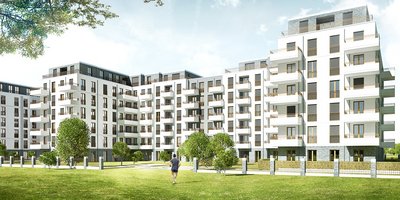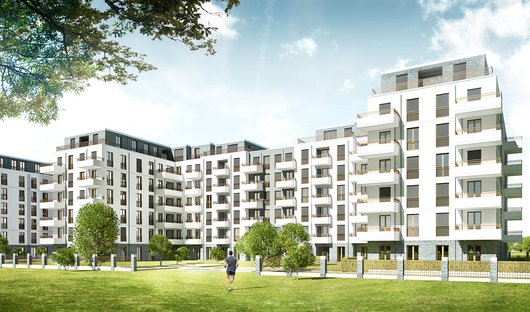
Construction of the NEUMARIEN residential complex
The BUWOG Group is building the housing complex NEUMARIEN on Berlin’s Mariendorfer Weg. PORR Design & Engineering planned both sections B and C.
The PORR subsidiary provided BUWOG with support and assistance from preliminary planning to execution planning. The entire project will be designed and realised with Building Information Modelling (BIM). Construction began on 1 February 2018.
-
EmployerBUWOG Berlin Wohnen GmbH
-
ContractorPORR Design & Engineering Deutschland GmbH
-
Order typeGeneralplanung
-
Project typeDesign & Engineering, General planning
-
Project scopeGeneral planning (Work Stages 2, 3, 4, 5 and 6 in accordance with HOAI, the German Scale of Fees for Services by Architects and Engineers
-
Construction startSpring 2018
-
Construction endSpring 2020
General
BUWOG is building a new housing complex with a total of 800 flats over an area of roughly 5.5ha on Mariendorfer Weg 41 to 48 in Berlin- Neukölln. Since February 2018, work on sections B and C in the northern part of the complex has been ongoing as part of the first construction stage. PORR Design & Engineering Deutschland GmbH (PDE) is responsible for the general planning for this stage. The gross floor area of both sections covers roughly 25,000m². Out of a total of 214 flats, 25% are subsidised. One third of the rental apartments have been designed as accessible housing. The two structures are connected via a shared underground parking garage. With a view to the future, 20 of the parking spaces have been allotted to electric vehicles, which will be controlled via a central cogeneration plant and substation located inside the building. A 500m² area within section C has also been designated for use as a nursery. Execution planning – in cooperation with the nursery operator- for this is currently underway. The buildings will be designed and erected in line with the DGNB gold standard. Among other things, this means that every contractor must comply with the minimum statutory requirements listed in the German Waste Management Act (Kreislaufwirtschaftsgesetz - KrWG). Contractors must also take care to use low-noise machinery and must also provide a complete record of all materials and auxiliary materials used.
Involving all planning participants from the beginning is a clear advantage. BIM data will later be of great benefit.
The project
Although PORR Bau GmbH was not commissioned to carry out the construction, PDE were able to provide a convincing demonstration of their expertise as general planners. After consulting with the client, a classic architectural style was chosen for the design and execution, with plain but generous French windows for optimum daylight, despite the fact that this was a subsidised, price-controlled residential construction scheme. The wide projecting balconies with a light use-dimension of roughly 2m also represent a high standard of quality in rental housing. The client deliberately chose a sustainable design with a timeless architectural style for later implementation. The scope of performance comprised general planning services, including architecture, mechanical & electrical engineering (M&E), structural engineering, fireproofing, building physics, sustainability and bid management (cost estimations).
PDE used BIM throughout the entire design process. This is a digital representation of all the architectural, technical, physical and functional properties of a building in one central data model. All the information from the design, construction and operation to the final demolition of a building, is collected, regularly updated and documented using BIM. Plans were made in close cooperation with the individual internal planners and the employer BUWOG and completed and handed over according to schedule and to everyone's complete satisfaction.
Construction method
Both buildings will be built as a solid construction; the ceilings and flat roofs will be made of reinforced concrete. Masonry will be used for the most part for the load-bearing walls, as well as reinforced concrete in places. Double-skinned plasterboard will be used for the non-load-bearing walls. The ground water level is well below the level of the foundations, which means that a cost-efficient construction method involving individual foundations and paving can be used for the underground garage.
Insulation
The insulated facades are coated with a mineral finishing and fitted with bands of clinker brick in places. The balconies, with a cantilever length of 2.23m, are thermally separated and integrated into the facade. The French windows with integrated guardrails are installed as plastic-frame windows with insulating glazing and a two-colour coating. The insulated flat roofs will be sealed with bitumen and extensive rooftop gardens will be planted.


Technical planning details
The BIM model is at the heart of the general planning process. The project will be supported digitally by BIM throughout all every Work Stage. Everyone involved in the project will work together with the 3D model, which can be expanded by the factors cost and time. This "digital twin" thus provides an overview of the entire life cycle of a building as early as the design stage.
Planning the design
On the basis of the preliminary draft created by the Berlin architectural firm GFB Architekten, the preliminary design plan and the design plan were revised in close coordination with all the professional planners involved, the client, and PDE. There was a strong focus on saving time, costs and resources in the architectural design, as well as in the mechanical & electrical engineering. Even the type of rental housing use was factored into the plans. An initial estimate of construction costs was also submitted. The architectural concept for the buildings was fleshed out and various alternative designs were visualised in the plans using three colour schemes. The plans were then presented to BUWOG as the basis for decision-making. The mechanical & electrical engineering plans were also created using BIM. The interdisciplinary BIM approach facilitated precise and detailed planning in line with LOD 300. Value engineering was also used to identify and make the best possible use of optimisation potentials. The structural engineering was also visualised in BIM. This allowed for significant reductions in time and material resources during the construction process. In order to minimise the energy consumption of NEUMARIEN, the buildings have been designed in
line with the current German Energy Saving Ordinance 2016. Fireproofing, sound insulation and spatial acoustics all played a large role in the plans as well. On the subject of sustainability, PDE has prepared for the gold DGNB building certification. The contract also included bid management. Cost indicators devised on the basis of experience with previous calculated and implemented projects were therefore provided during the design planning stage.
The approval planning process
Thanks to the detailed design plans, it was possible to submit the approval plans immediately afterwards. Due to the excellent communication between PDE, the project managers and the responsible building authorities, and the detailed approval plans, planning permission was obtained from the authorities ahead of time, after a review period of just four and a half months.
Execution planning
Before the execution plans were created at a scale of 1:50, all the unresolved details had to be cleared up. These included all the details regarding execution quality, tolerances, and processing guidelines. BIM-supported modelling systems were used to calculate the exact quantities needed for construction, which were then factored into the detailed estimate. It was also possible to provide a more detailed estimate of the M&E costs in this Work Stage.
Summary
The NEUMARIEN project once again illustrates the importance of integrating everyone involved in the planning process from the outset. This allowed PDE, as the general planner and in cooperation with all the in-house planning
divisions, to design a sustainable and cost-efficient housing complex for BUWOG to the client's complete satisfaction. The data derived from the BIM will also be very useful once the complex is in use.
Technical data
-
Residential units214
-
Storeysbasement, 6 full storeys, 1 offset story
